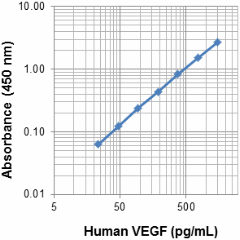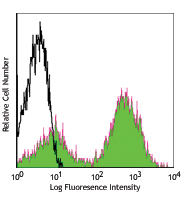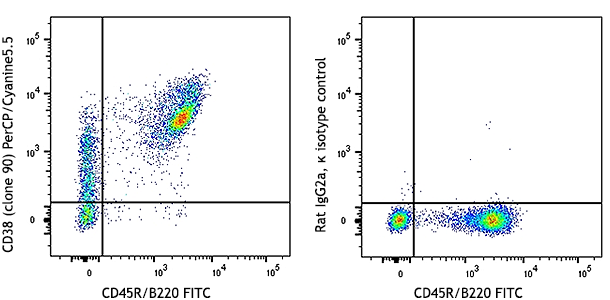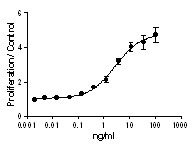- Regulatory Status
- RUO
- Other Names
- VEGFA165, MVCD1, VEGF, Vascular permeability factor (VPF), VEGFA,VEGF-A, VEGF-121,Vascular endothelial growth factor
- Ave. Rating
- Submit a Review
- Product Citations
- publications

VEGF (also known as VEGF-A) is a signaling protein with strong vascular permeability activity that stimulates the formation of new blood vessels during the processes of vasculogenesis and angiogenesis. It is a member of the vascular endothelial growth factor family, which in mammals is comprised of VEGF-A, VEGF-B, VEGF-C, VEGF-D, and PlGF (placental growth factor). There are multiple isoforms of VEGF that result from alternative splicing of mRNA. VEGF binds and activates two tyrosine kinase receptors, VEGFR1 (Flt-1) and VEGFR2 (KDR/Flk-1), through which VEGF exerts its mitogenic effects. VEGF is highly expressed in solid tumors of breast, lung, renal, colorectal, and hepatic origin. Additionally, it significantly contributes to ascites tumor formation. Beyond cancer, VEGF has also been associated with multiple pathogenic conditions including rheumatoid arthritis, age-related macular degeneration, Crow-Fukase syndrome, sclerosis and Alzheimer’s disease.
The BioLegend LEGEND MAX™ Human VEGF Sandwich Enzyme-Linked Immunosorbent Assay (ELISA) kit includes a 96-well strip plate that is pre-coated with a mouse monoclonal anti-human VEGF capture antibody. The detection antibody is a biotinylated goat polyclonal anti-human VEGF antibody. This kit is specifically designed for the accurate quantitation of free-form human VEGF from cell culture supernatant, serum, plasma, and other biological fluids. It is analytically validated with ready-to-use reagents.
Kit Contents
- Kit Contents
-
- Anti-Human VEGF Pre-coated 96-well Strip Microplate
- Human VEGF Dectection Antibody
- Human VEGF Standard
- Avidin-HRP
- Assay Buffer A
- Assay Diluent D
- Wash Buffer (20X)
- Substrate Solution F
- Stop Solution
- Plate Sealers
Product Details
- Verified Reactivity
- Human
- Application
-
ELISA
- Sensitivity
- 4.1+ 2.2 pg/mL
- Standard Range
- 23.4-1,500 pg/mL
- Materials Not Included
-
- Microplate reader able to measure absorbance at 450 nm
- Adjustable pipettes to measure volumes ranging from 1 µL to 1,000 µL
- Deionized water
- Wash bottle or automated microplate washer
- Log-Log graph paper or software for data analysis
- Polypropylene Tubes to prepare standard dilutions
- Timer
- Plate Shaker
- Polypropylene vials
Antigen Details
- Biology Area
- Angiogenesis, Cell Biology, Neuroscience, Stem Cells, Synaptic Biology
- Molecular Family
- Cytokines/Chemokines, Growth Factors
- Gene ID
- 7422 View all products for this Gene ID
- UniProt
- View information about VEGF on UniProt.org
Related Pages & Pathways
Pages
Related FAQs
- In your LEGEND MAX™ ELISA Kits, there is a step that calls for washing the plates before adding sample. What is the purpose of this step?
-
We typically use a stabilizer for pre-coated plates. The additional washing step is designed to remove these components before you start the assay. If you do not perform the washing, the effect on assay performance is negligible.
- I have multiple LEGEND MAX™ ELISA kits that I want to run simultaneously. Can I use the same wash buffer for all the kits?
-
The wash buffer provided in all our LEGEND MAX™ kits is the same and the part numbers on the wash buffer bottles in these kits should be identical. For ELISA MAX™ Deluxe and ELISA MAX™ Standard Sets, we provide a recipe for the wash buffer on each kit’s technical data sheet. This recipe is the same for all ELISA MAX™ sets.
- For some of your ELISA kits, why do my serum samples require dilution with assay buffer?
-
In some cases, dilution with assay buffer is required to minimize the matrix difference between the samples and the standards to achieve better accuracy.













Follow Us